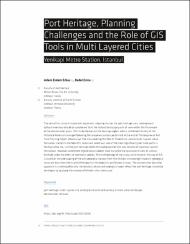Mimar Sinan Güzel Sanatlar Üniversitesi Açık Bilim, Sanat Arşivi
Açık Bilim, Sanat Arşivi, Mimar Sinan Güzel Sanatlar Üniversitesi tarafından doğrudan ve dolaylı olarak yayınlanan; kitap, makale, tez, bildiri, rapor gibi tüm akademik kaynakları uluslararası standartlarda dijital ortamda depolar, Üniversitenin akademik performansını izlemeye aracılık eder, kaynakları uzun süreli saklar ve yayınların etkisini artırmak için telif haklarına uygun olarak Açık Erişime sunar.MSGSÜ'de Ara
Port heritage, planning challenges and the role of gis tools in multi layered cities: Yenikapi metro station, Istanbul
| dc.contributor.author | Erbaş, Adem Erdem | |
| dc.contributor.author | Emre, B. | |
| dc.date.accessioned | 2023-05-18T06:16:02Z | |
| dc.date.available | 2023-05-18T06:16:02Z | |
| dc.date.issued | 2021 | en_US |
| dc.identifier.citation | Erbas, A. E., & Emre, B. (2021). Port Heritage, Planning Challenges and the Role of GIS Tools in Multi Layered Cities: Yenikapi Metro Station, Istanbul. SPOOL, 8(1), 23–48. https://doi.org/10.7480/spool.2021.1.5904 | en_US |
| dc.identifier.issn | 22150897 | |
| dc.identifier.uri | https://hdl.handle.net/20.500.14124/5238 | |
| dc.identifier.uri | https://doi.org/10.7480/spool.2021.1.5904 | |
| dc.description.abstract | The aim of this study is to present arguments showing that on the port heritage area, underground cultural inventory should be considered from the historic landscape point of view within the framework of the conservation plans. This study focuses on the Yenikapı region, whose settlement history of the Historical Peninsula changed following the rescue excavation performed at the end of The Bosphorus Rail Tube Crossing Project (Marmaray). The area covering the Port of Theodosius, whose multi-layered urban formation started in the Neolithic period and which was one of the most significant grain trade ports in the Byzantine era, and the port heritage within the background of this area consist of important spatial formations. However, waterfront regeneration projects have disrupted the spatial continuity of cultural heritage under the effect of neoliberal policies. The methodology of the study, which involves the use of GIS, is based on the overlapping of the archaeological surveys from the Istanbul Archaeology Museum, geological structure data from the Istanbul Metropolitan Municipality, and historical maps. The conservation planning approach in a metropolitan city like Istanbul, whose archaeological layers reflect the port heritage, should be developed by applying the concept of historic urban landscape. © 2021, TU Delft. All rights reserved. | en_US |
| dc.language.iso | eng | en_US |
| dc.publisher | Technische Universiteit Delft/Delft University of Technology | en_US |
| dc.relation.ispartof | Spool | en_US |
| dc.rights | info:eu-repo/semantics/openAccess | en_US |
| dc.subject | port heritage | en_US |
| dc.subject | multi-layered city | en_US |
| dc.subject | underground cultural inventory | en_US |
| dc.subject | historic urban landscape | en_US |
| dc.subject | conservation | en_US |
| dc.subject | renewal | en_US |
| dc.title | Port heritage, planning challenges and the role of gis tools in multi layered cities: Yenikapi metro station, Istanbul | en_US |
| dc.type | article | en_US |
| dc.authorid | 0000-0002-5979-3047 | en_US |
| dc.department | Fakülteler, Mimarlık Fakültesi, Şehir ve Bölge Planlama Bölümü | en_US |
| dc.institutionauthor | Erbaş, Adem Erdem | |
| dc.identifier.doi | 10.7480/spool.2021.1.5904 | |
| dc.identifier.volume | 8 | en_US |
| dc.identifier.issue | 1 | en_US |
| dc.identifier.startpage | 23 | en_US |
| dc.identifier.endpage | 48 | en_US |
| dc.relation.publicationcategory | Makale - Uluslararası Hakemli Dergi - Kurum Öğretim Elemanı | en_US |
| dc.authorwosid | CPO-3585-2022 | en_US |
| dc.authorscopusid | 6504031350 | en_US |
| dc.identifier.wosquality | Q4 | en_US |
| dc.indekslendigikaynak | Scopus |
Bu öğenin dosyaları:
Bu öğe aşağıdaki koleksiyon(lar)da görünmektedir.
-
Տcopus [1592]
Scopus | Abstract and citation database















